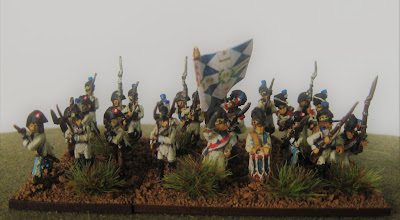There is a French Revolutionary Wars Appendix in Barry Hilton’s Republic to Empire. It makes for an interesting read. As ever he weighs the evidence and gives us options on how to game it. The system is basing neutral which is always helpful.
He sees a Demi Brigade as comprising three battalions each of between 20 to 40 figures. Big then, although my 16 figure battalions could simply be understrength. Or, I could double them up. The rules will still work either way.
One of the three battalions (le blancs) is rated Drilled or Drilled Elite.
The other two are le bleus who are Recruits or Recruits Elite.
All fine there.
Should you wish one of the battalions can be dispersed as skirmishers, grande bande style. It will be hard to reform such soldiers once so deployed.
There are some fine touches. le bleus fight with extra
effect should they close. Nor do they need much encouragement to do so. For added zing charismatic officers can add more combat dice. Conversely, they are very nervous about
cavalry and are prone to losing formation.
That is all good from my perspective.
There is more too but it need not detain us here. Suffice to say Republic to Empire is a good thing.
A feature of these rules is that troops fight by Combat Group. A Combat Group is 4 figures. Throw a dice for each Combat Group sort of thing. There is also a combat plus for pike armed troops. All good and it opens the door to the Vendéans. Let us consider how.
The best Vendéan units had the most muskets. No Vendéan unit had a musket for every man. I could field a Vendéan unit of say 24 figures as follows. Sixteen musket armed troops and eight pikemen. They might be Drilled Elite.
The next best Vendéan units had less muskets than the best. Perhaps a unit of 24 such fellows would have 12 musket armed troops and 12 pikemen. Or, 8 muskets and 16 pike men.
Obviously, the Combat Group concept allows for permutations of the ratio of musket to pike. Such fellows might be Drilled or Recruit Elite.
The worst Vendéan units had few muskets. Taking our notional 24 figure unit we might say 4 muskets and 20 pike men.
These lads, always committed last, might be deemed Recruits.
While we are on matters Vendéan I bought a bag of command figures from Stonewall for mine. Most are simply too big to match Lancashire Archive range. These two (above centre) sort of fit well enough.
I find this all very satisfying. Mr Hilton sold me my new copy of Republic to
Empire for £10.00. That was satisfying too. He may have some
left. It is the best two pints you never
had. Economics is not, you may know, a Science.
Republic to Empire belongs an earlier stage of Barry’s rule writing evolution. The generation of action points (Manouvere Points) reminds me of the Piquet/FoB system.
The difference? You generate points at every turn, rather than at the outset.
How? You throw an average dice for every brigade still at 50% or better of it's original strength. The total is the number of points you have to expend that turn.
No cards though, instead, the more difficult the action the more points you will spend. It is solid throughout and easy to learn.
I considered using his War of Three Kings order system but that caters for an earlier and simpler form of warfare. So far, I have not found an elegant way of adapting the one to the other. Indeed, perhaps that should not be attempted.
Having moved on, eyes now open. I began to see a new Order and a new troop type that would allow me to extend the scope of Republic to Empire to the Anglo-Sikh Wars. I will do a separate post on that.
All for a tenner.
I got Warbases to do me some nice brigade order tokens. The rules don’t require them but I will find them handy. I'll have more to add on this subsequent.
The Brigade Order tokens below.
I should add, my initial motivation in buying Republic to Empire was its application for the Crimean War. That is the ongoing project for the moment. Research is proving challenging.
Meantime, I have a first draft of a Anglo-Sikh War Appendix for Republic to Empire. I intend a refight of the Battle of Mudki by way of proof of concept. I'll report back in the New Year.
Meantime, Dear Reader, have a Merry Christmas and a Happy New Year.

























